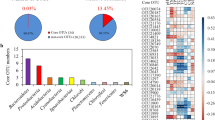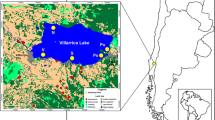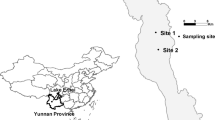Abstract
Purpose
We determined the relationship of a planktonic algal bloom with spatial and temporal changes in sediment bacterial communities in a eutrophic urban river in the Taihu Basin, China.
Materials and methods
Surface sediments from different locations on the river, including with and without an algal bloom, were collected monthly for 1 year. Sediment bacterial communities were assessed by sequencing 16S rRNA gene amplicons using an Illumina MiSeq.
Results and discussion
There were distinct spatial and temporal changes in sediment bacterial community structure. Significant decrease in the Shannon diversity corresponded with the peak chlorophyll a (Chl a) concentration. Proteobacteria, Chloroflexi, and Bacteroidetes were the dominant phyla throughout the year; however, their relative abundances changed seasonally. At the time of peak Chl a concentrations, Proteobacteria and Bacteroidetes comprised a greater proportion of the bacterial community. Bacterial community structure also varied spatially at the operational taxonomic unit (OTU) level according to canonical correspondence analysis (CCA), especially in locations with an algal bloom compared with those without an algal bloom. There were positive correlations between multiple bacterial genera and Chl a content, suggesting the potential for facilitative relationships between phytoplankton and bacteria. Based on the CCA, water temperature, NH4 +-N, TN, NO3 −-N, and TP in the sediment and Chl a contents in the water column were significantly correlated with sediment bacterial community structure (P < 0.05).
Conclusions
Planktonic algal blooms may influence sediment bacterial community structure at all taxonomic levels in urban rivers. This work emphasizes the need for more comprehensive studies regarding the impact of planktonic algal blooms on sediment bacterial communities.





Similar content being viewed by others
References
Aller JY, Aller RC (2004) Physical disturbance creates bacterial dominance of benthic biological communities in tropical deltaic environments of the Gulf of Papua. Cont Shelf Res 24:2395–2416
Allison SD, Martiny JBH (2008) Resistance, resilience, and redundancy in microbial communities. Proc Natl Acad Sci U S A 105(Supplement 1):11512–11519
Anderson DM, Glibert PM, Burkholder JM (2002) Harmful algal blooms and eutrophication: nutrient sources, composition, and consequences. Estuar Coasts 25:704–726
Bagatini IL, Eiler A, Bertilsson S, Klaveness D, Tessarolli LP, Henriques Vieira AA (2014) Host-specificity and dynamics in bacterial communities associated with bloom-forming freshwater phytoplankton. PLoS One 9:e85950
Blackburn H (1995) The role and regulation of microbes in sediment nitrogen cycle. In: Molecular ecology of aquatic microbes, Springer, Berlin-Heidelberg, Germany, pp 55–71
Bouzat JL, Hoostal MJ, Looft T (2013) Spatial patterns of bacterial community composition within Lake Erie sediments. J Great Lakes Res 39:344–351
Bremner JM (1960) Determination of nitrogen in soil by the Kjeldahl method. J Agr Sci-Cambridge 55:11–33
Brum JR, Hurwitz BL, Schofield O, Ducklow HW, Sullivan MB (2016) Seasonal time bombs: dominant temperate viruses affect Southern Ocean microbial dynamics. ISME J 10:437–449
Buckley DH, Huangyutitham V, Hsu S, Nelson TA (2007) Stable isotope probing with 15N achieved by disentangling the effects of genome G+C content and isotope enrichment on DNA density. Appl Environ Microbiol 73:3189–3195
Caporaso JG, Lauber CL, Walters WA, Berg-Lyons D, Huntley J, Fierer N, Owens SM, Betley J, Fraser L, Bauer M, Gormley N, Gilbert JA, Smith G, Knight R (2012) Ultra-high-throughput microbial community analysis on the Illumina HiSeq and MiSeq platforms. ISME J 6:1621–1624
Chen C, Zhang Z, Ding A, Wu J, Xiao J, Sun Y (2011) Bar-coded pyrosequencing reveals the bacterial community during Microcystis water bloom in Guanting reservoir, Beijing. Procedia Eng 18:341–346
Chen N, Yang J, Qu J, Li H, Liu W, Li B, Wang ET, Yuan H (2015) Sediment prokaryote communities in different sites of eutrophic Lake Taihu and their interactions with environmental factors. World J Microbiol Biotechnol 31:883–896
Cloern JE (1999) The relative importance of light and nutrient limitation of phytoplankton growth: a simple index of coastal ecosystem sensitivity to nutrient enrichment. Aquat Ecol 33:3–15
Cole JK, Peacock JP, Dodsworth JA, Williams AJ, Thompson DB, Dong HL, Wu G, Hedlund BP (2013) Sediment microbial communities in great boiling spring are controlled by temperature and distinct from water communities. ISME J 7:718–729
Dang H, Chen R, Wang L, Guo L, Chen P, Tang Z, Tian F, Li S, Klotz MG (2010) Environmental factors shape sediment anammox bacterial communities in hypernutrified Jiaozhou Bay, China. Appl Environ Microbiol 76:7036–7047
de Moraes PC, Franco DC, Pellizari VH, Gomes Sumida PY (2014) Effect of plankton-derived organic matter on the microbial community of coastal marine sediments. J Exp Mar Biol Ecol 461:257–266
Diao X, Li Y, Wang S (2015) Effects of outbreak and extinction of algal blooms on the microbial community structure in sediments of Chaohu Lake. Environmental Science 36:107–113 (in Chinese)
Ebina J, Tsutsui T, Shirai T (1983) Simultaneous determination of total nitrogen and total phosphorus in water using peroxodisulfate oxidation. Water Res 17:1721–1726
Edgar RC (2010) Search and clustering orders of magnitude faster than BLAST. Bioinformatics 26:2460–2461
Edgar RC, Haas BJ, Clemente JC, Quince C, Knight R (2011) UCHIME improves sensitivity and speed of chimera detection. Bioinformatics 27:2194–2200
Eiler A, Bertilsson S (2004) Composition of freshwater bacterial communities associated with cyanobacterial blooms in four Swedish lakes. Environ Microbiol 6:1228–1243
Fagervold SK, Bourgeois S, Pruski AM, Charles F, Kerhervé P, Vétion G, Galand PE (2014) River organic matter shapes microbial communities in the sediment of the Rhône prodelta. ISME J 8:2327–2338
Fodelianakis S, Papageorgiou N, Karakassis I, Ladoukakis ED (2015) Community structure changes in sediment bacterial communities along an organic enrichment gradient associated with fish farming. Ann Microbiol 65:331–338
Franco MA, De Mesel I, Diallo MD, Van der Gucht K, Van Gansbeke D, Van Rijswijk P, Costa MJ, Vincx M, Vanaverbeke J (2007) Effect of phytoplankton bloom deposition on benthic bacterial communities in two contrasting sediments in the southern North Sea. Aquat Microb Ecol 48:241–254
Graf G, Bengtsson W, Diesner U, Schulz R, Theede H (1982) Benthic response to sedimentation of a spring phytoplankton bloom: process and budget. Mar Biol 67:201–208
Guevara R, Ikenaga M, Dean AL, Pisani C, Boyer JN (2014) Changes in sediment bacterial community in response to long-term nutrient enrichment in a subtropical seagrass-dominated estuary. Microb Ecol 68:427–440
Haller L, Tonolla M, Zopfi J, Peduzzi R, Wildi W, Pote J (2011) Composition of bacterial and archaeal communities in freshwater sediments with different contamination levels (Lake Geneva, Switzerland). Water Res 45:1213–1228
Hecky RE, Kilham P (1988) Nutrient limitation of phytoplankton in freshwater and marine environments: a review of recent evidence on the effects of enrichment. Limnol Oceanogr 33:796–822
Huang L, Du S, Fan L, Lin X, Wang H, Zhang Y (2011) Microbial activity facilitates phosphorus adsorption to shallow lake sediment. J Soils Sediments 11:185–193
Imamura N, Motoike I, Noda M, Adachi K, Konno A, Fukami H (2000) Argimicin a, a novel anti-cyanobacterial compound produced by an algae-lysing bacterium. J Antibiot 53:1317–1319
Jespersen AM, Christoffersen K (1987) Measurements of chlorophyll-a from phytoplankton using ethanol as extraction solvent. Archiv für Hydrobiol 109:445–454
Lee S, Kato J, Takiguchil N, Kuroda A, Ikeda T, Mitsutani A, Ohtake H (2002) Involvement of an extracellular protease in algicidal activity of the marine bacterium Pseudoalt eromonas sp. strain A28. Appl Environ Microbiol 66:4334–4339
Liao X, Chen C, Wang Z, Wan R, Chang C, Zhang X, Xie S (2013) Changes of biomass and bacterial communities in biological activated carbon filters for drinking water treatment. Process Biochem 48:312–316
Mattingly GEG (1970) Total phosphorus contents of soils by perchloric acid digestion and sodium carbonate fusion. J Agr Sci-Cambridge 74:79–82
Murphy J, Riley JP (1962) A modified single solution method for the determination of phosphate in natural waters. Anal Chim Acta 27:31–36
Newton RJ, McMahon KD (2011) Seasonal differences in bacterial community composition following nutrient additions in a eutrophic lake. Environ Microbiol 13:887–899
Nürnberg GK (1996) Trophic state of clear and colored, soft-and hardwater lakes with special consideration of nutrients, anoxia, phytoplankton and fish. Lake Reservoir Manage 12:432–447
Oksanen J, Blanchet FG, Kindt R, Legendre P, Minchin PR, Simpson GL, Solymos P, Stevens M, Wagner HH (2011) Reference Manual for Package ‘vegan’. R Foundation for Statistical Computing, Vienna, Austria
Oribhabor BJ, Udoidiong OM, Udoh DF, Akpan BE (2013) Evaluation of the ecological impact of human settlement on the water quality of lower Cross River, Nigeria, Nigeria. J Ecosyst 2013:12
Paerl HW, Pinckney JL (1996) A mini-review of microbial consortia: their roles in aquatic production and biogeochemical cycling. Microb Ecol 31:225–247
Paerl HW, Fulton RS, Moisander PH, Dyble J (2001) Harmful freshwater algal blooms, with an emphasis on cyanobacteria. Sci World J 1:76–113
Paerl HW, Dyble J, Moisander PH, Noble RT, Piehler MF, Pinckney JL, Steppe TF, Twomey L, Valdes LM (2003) Microbial indicators of aquatic ecosystem change: current applications to eutrophication studies. FEMS Microbiol Ecol 46:233–246
Rice EW, Bridgewater L (2012) Standard methods for the examination of water and wastewater. American Public Health Association, Washington
Robador A, Brüchert V, Jørgensen BB (2009) The impact of temperature change on the activity and community composition of sulfate-reducing bacteria in arctic versus temperate marine sediments. Environ Microbiol 11:1692–1703
Rooney-Varga JN, Giewat MW, Savin MC, Sood S, LeGresley M, Martin JL (2005) Links between phytoplankton and bacterial community dynamics in a coastal marine environment. Microb Ecol 49:163–175
Salcher MM, Hofer J, Hornak K, Jezbera J, Sonntag B, Vrba J, Simek K, Posch T (2007) Modulation of microbial predator-prey dynamics by phosphorus availability: growth patterns and survival strategies of bacterial phylogenetic clades. FEMS Microbiol Ecol 60:40–50
Sandrini G, Matthijs H, Verspagen J, Muyzer G, Huisman J (2014) Genetic diversity of inorganic carbon uptake systems causes variation in CO2 response of the cyanobacterium Microcystis. ISME J 8:589–600
Shao K, Gao G, Qin B, Tang X, Wang Y, Chi K, Dai J (2011) Comparing sediment bacterial communities in the macrophyte-dominated and algae-dominated areas of eutrophic Lake Taihu, China. Can J Microbiol 57:263–272
Smit E, Leeflang P, Gommans S, van den Broek J, van Mil S, Wernars K (2001) Diversity and seasonal fluctuations of the dominant members of the bacterial soil community in a wheat field as determined by cultivation and molecular methods. Appl Environ Microbiol 67:2284–2291
Smith VH, Tilman GD, Nekola JC (1999) Eutrophication: impacts of excess nutrient inputs on freshwater, marine, and terrestrial ecosystems. Environ Pollut 100:179–196
Taylor KG, Owens PN (2009) Sediments in urban river basins: a review of sediment–contaminant dynamics in an environmental system conditioned by human activities. J Soils Sediments 9:281–303
Ter Braak CJF (1986) Canonical correspondence analysis: a new eigenvector technique for multivariate direct gradient analysis. Ecology 67:1167–1179
van Duyl FC, van Raaphorst W, Kop AJ (1993) Benthic bacterial production and nutrient sediment-water exchange in sandy North Sea sediments. Mar Ecol Prog Ser 100:85–95
Vanaverbeke J, Soetaert K, Vincx M (2004) Changes in morphometric characteristics of nematode communities during a spring phytoplankton bloom deposition. Mar Ecol:Prog Ser 273:139–146
Wang X, Gong L, Liang S, Han X, Zhu C, Li Y (2005) Algicidal activity of rhamnolipid biosurfactants produced by Pseudomonas aeruginosa. Harmful Algae 4:433–443
Wetzel RG (1983) Limnology. Philadelphia, New York
Wildung RE, Schmidt RL (1973) Phosphorus release from lake sediments. EPA, Washington
Wu Q, Zhang R, Huang S, Zhang H (2008) Effects of bacteria on nitrogen and phosphorus release from river sediment. J Environ Sci-China 20:404–412
Wu YC, Ke XB, Hernández M, Wang BZ, Dumont MG, Jia ZJ, Conrad R (2013) Autotrophic growth of bacterial and archaeal ammonia oxidizers in freshwater sediment microcosms incubated at different temperatures. Appl Environ Microbiol 79:3076–3084
Yang C, Li Y, Zhou Y, Lei X, Zheng W, Tian Y, Van Nostrand JD, He Z, Wu L, Zhou J, Zheng T (2016) A comprehensive insight into functional profiles of free-living microbial community responses to a toxic Akashiwo sanguinea bloom. Sci Rep 6:34645
Zeder M, Peter S, Shabarova T, Pernthaler J (2009) A small population of planktonic Flavobacteria with disproportionally high growth during the spring phytoplankton bloom in a prealpine lake. Environ Microbiol 11:2676–2686
Zhou Z, Li H, Song C, Cao X, Zhou Y (2017) Prevalence of ammonia-oxidizing bacteria over ammonia-oxidizing archaea in sediments as related to nutrient loading in Chinese aquaculture ponds. J Soils Sediments. doi:10.1007/s11368-017-1651-2
Zhu J, Zhang J, Li Q, Han T, Xie J, Hu Y, Chai L (2013) Phylogenetic analysis of bacterial community composition in sediment contaminated with multiple heavy metals from the Xiangjiang River in China. Mar Pollut Bull 70:134–139
Acknowledgements
This study was supported by the National Natural Scientific Foundation of China (grants 41371256 and 41622104), the Distinguished Young Scholar Program of the Jiangsu Province (grant BK20160050), the Major Science and Technology Program for Water Pollution Control and Treatment (grant 2012ZX07301001), and the Youth Innovation Promotion Association of Chinese Academy of Sciences (grant 2016284). We also sincerely thank Marie Louise Bornø from University of Copenhagen for help in revising the English.
Author information
Authors and Affiliations
Corresponding author
Additional information
Responsible editor: John R. Lawrence
Rights and permissions
About this article
Cite this article
Xiao, X., Pei, M., Liu, X. et al. Planktonic algal bloom significantly alters sediment bacterial community structure. J Soils Sediments 17, 2547–2556 (2017). https://doi.org/10.1007/s11368-017-1691-7
Received:
Accepted:
Published:
Issue Date:
DOI: https://doi.org/10.1007/s11368-017-1691-7




